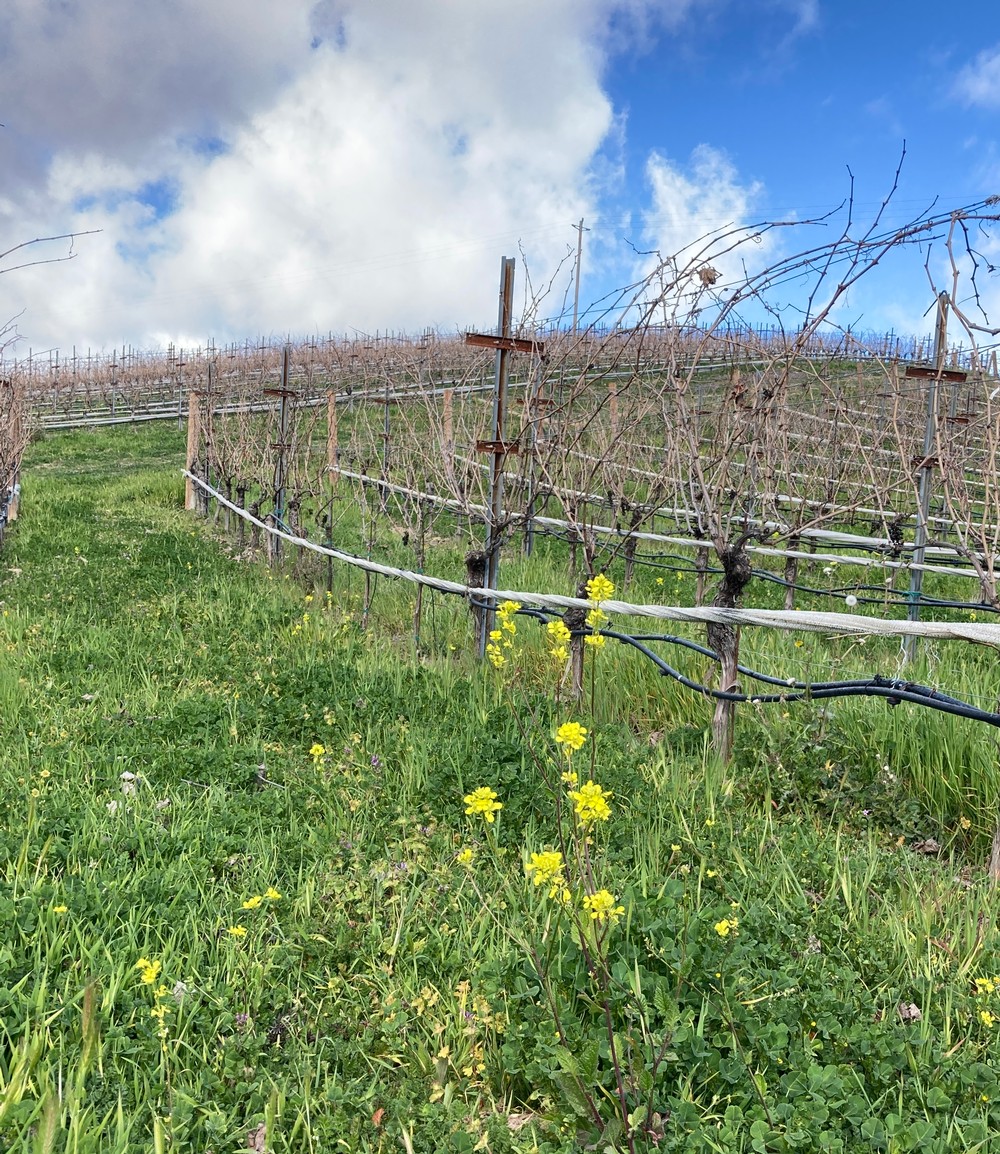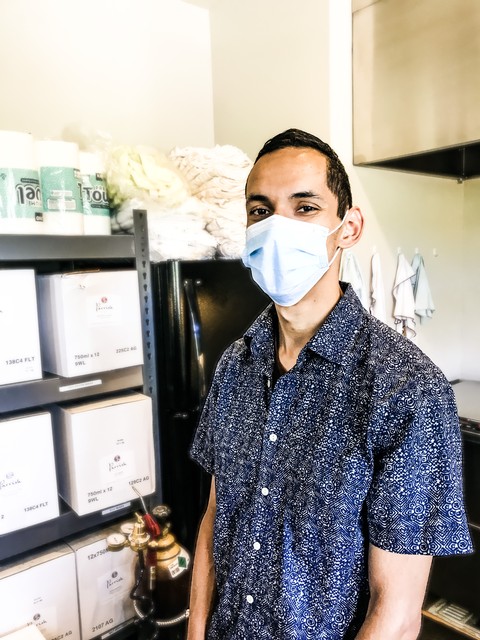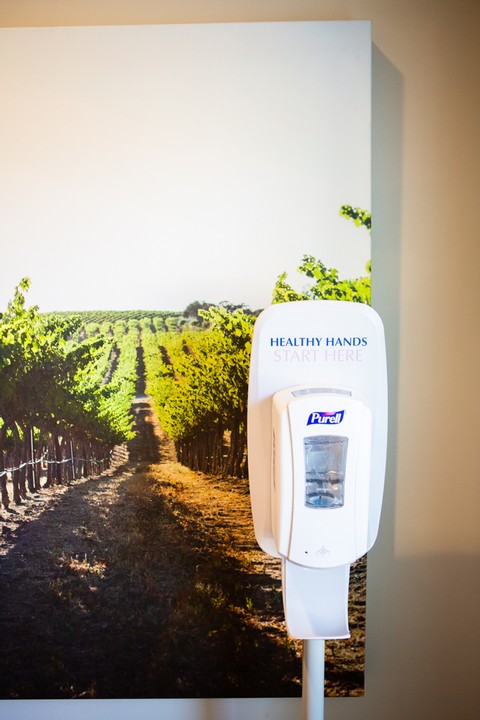Parrish Family Vineyard Blog
Keep up with the Parrish Family Vineyard!
Vines & Wines
Discover more about the Parrish vineyards & winery.
Wine & Food
Wine and food offerings and pairings.
Events
Learn more about upcoming Parrish events & specials!
Visit Paso Robles
Visiting Paso Robles soon? Learn of wineries, food, and lodging for your next trip to Paso Robles' wine country.
Late Harvest Sauvignon Blanc Pairing Suggestions

Our 2019 Late Harvest Sauvignon Blanc is our sweet wine on the menu and delivers notes of apricot, pineapple, banana and orange sherbet. It features estate grown Sauvignon Blanc that we allow to stay on the vine longer into the season to develop more sugar, so it is considered a dessert wine. The wine is perfect with sweet treats or cheese & charcuterie plates. Sweet wines pair best with sweet foods, but cheese with the creaminess and salt can also be a delicious pairing.
I've compiled a list of desserts and cheeses that would pair well with our Late Harvest to inspire your upcoming hosting and holiday season! (Graphic Above) One last idea for using the Late Harvest Sauvignon Blanc, is that you can do a reduction to create a delicious sauce to top desserts like ice cream, flourless chocolate cake, or cheesecake. We hope you enjoy this sweet treat at your next get together or just because!
Winter in the Vineyard
Bare vines and dark soil spotted with green grass speckle the hillsides as puffy clouds pass overhead in the vineyard. The quiet landscape of the season, while simple, is beautiful. Despite the tranquility, there is still work to be done and activity begins weeks before the end of Winter.
The first task is composting. Tractors spread it between the rows of the bare vines, which awakes the vineyard to the season ahead. It takes 2 years for the compost to be used by the soil. That's correct, two years. I thought it would have been immediate, but microorganisms in the soil have to break it down. Once it breaks down it gives the soil carbon, nitrogen, and minerals that feed the vine's root system. We have to do this as the vine loses these elements every harvest. We use organic compost instead of chemical compost as it is sustainable. Organic compost also doesn't encourage overgrowth in the vineyard. As my dad shared, chemical compost can act like steroids for a vineyard. We want growth, but not that kind of growth.
The next task is pruning. The vineyard gets a haircut with the old wood being pruned. The pruner keeps two canes (old shoots) on the vine for this year's growth. It is a job that requires time and diligence. We prune later in the Winter to protect the vine from disease. Timing is everything in farming.
Once trimmed, the vine awaits bud break. It is my favorite time of year as the bare vines show life again (even though I know the vines are alive during the Winter...haha). Till then, bring a blanket or coat, and enjoy the tranquility at the tasting room.
Cheers!
-Cecily
Wine Temperature
"We're having a heatwave, A tropical heatwave. The temperature's rising, It isn't surprising..."
Sung by Marilyn Monroe (There's No Business Like Show Business,1954) echoes in my mind as the Summer months hit. While Summer is bright and happy, I find myself to be like wine and prefer milder temperatures. So, it brings up a question that we frequently get in the tasting room, how do you properly store wine? It's a great question because there are definitely ways to keep wine temperatures perfect.

Traveling with Wine
You are meandering the beautiful roads of Paso Robles. Hopefully, you're on Adelaida Road because it's one of my favorites in the area (not biased, right?!). You have the windows down, wind blowing, and you smell the wild grasses of wine country. You're happy even though it's 90 degrees out. Well, there's one thing in the car not so stoked on life and that's the wine you just bought. It's too darn hot for the wine! There are ways to ease the transport for your wine.
- Store your wines in a cooler or a fun wine chilling bag. Check on the temperature frequently. Add ice packs as needed.
- Bring your wines with you. It's okay to bring your wines into the next tasting room. We love our neighbors and would hate for their wine to spoil in the car.
- Plan on stopping at your hotel/B&B/inn during the day to put your bottles in the chilled room.
- Take a tour! Let someone else drive, enjoy your tastings, and let them handle the wine temperature. Our friends at Toast Tours will always carry your wine out for you.
- Have your wine shipped by the tasting room. Keep in mind that shipping is expensive year round, but it is more expensive to ship with temperature control, but it is an option.

At Home - How to Store Wine
Most of us do not have a dream wine cellar waiting at home. Instead, we have a workhorse Whirlpool fridge that holds our dietary treasures or a cramped master bedroom closet with shoes that need shaping. Do you have to get a wine fridge? The answer is that it depends on you.
What kind of wine drinker are you is the question you should ask before spending money on a wine fridge. So, are you...
- Buy as you go or enjoy soon - Store in your home fridge
- Enjoy good wine and store quite a bit - Get a mid-range wine fridge
- Wine enthusiast - Put some money into a nice wine fridge or cellar (Obviously, a wine enthusiast is not reading this blog because they already know this, but maybe we have some wine enthusiast beginners!)
- Super wine enthusiast with no space - Rent storage at a wine storage facility. These do exist as we ship orders to wine storage facilities.
There are some tips regarding wine storage that can help you further decide how to best store your wine and if a wine fridge is necessary for your wine enjoyment.
- Constant temperature. Wine does not like fluctuating temperatures. Store consistently at about 45-65 ℉.
- There are wine fridges with multiple zones, which are great for keeping whites chilled at 45℉ and reds at 60℉. It's easier for serving wine to have the storing temperature not too far off from what you plan on serving wine at.
- If you are going to store a wine for a long time, have the temperature a little cooler to assist with smooth aging. 50℉ is recommended for a red wine.
- Don't go below 40℉ for wine (unless it's bubbles). Too cold can also be harmful for wine.
- If you cannot afford a wine fridge, and that's okay, do your best! I would pick your home fridge first or a basement cellar. If you can keep your home at a constant temperature, a closet would work as well.
- Somewhere dark. Light actually can tamper with the wine's structure and ultimately hurt the flavor profile.
- Avoid lots of movement and vibrations. It disrupts the aging process by disturbing the sediment.
- Think about the corks as they can dry out. Store your wines horizontially (or upside-down in a case box). If you do have a wine fridge, use humidity. I'd say like 65% is a good precentage.

Opening Wine & Serving
Once you open a wine, oxygen is now in contact and that begins to change the wine as it starts a ticking clock of how long you have till the wine is lack-luster. You may think serving wine is not super important, but it does make a difference in how a wine showcases itself.
- Serving suggestions
- Serve red at like 58-65℉ - warmer for older wines, cooler for younger wines
- White wines at 45-55℉
- Bubbles actually can be served at 38-45℉
- Let red wine breath a little. I'd generally recommend an hour before serving opening the wine and this is especially true for younger wines. It will help the wines express more aroma and flavors. You can use a decanter or an aerator to assist with this also.
- Keep whites chilled as you enjoy. This can be done by keeping the bottle in your home fridge or having a chilling bucket on your table. Also, hold your wine glass by the stem so you do not warm the bowl of the glass.
- Use a Coravin for those wines you want to savor. I'm not a Coravin rep, but honestly it's great for sampling or enjoying just a glass of a special wine.
- Wines that have been opened can last for different times.
- Lighter wines and whites - 1 or 2 days
- Red wines and heavier bodied wines - 3 days
- Ports and high alcohol wines - weeks (maybe months depending on the alcohol)

Is your head spinnning yet? No worries. I wrote this not only for you, but for myself as I can't remember all the tidbits sometimes. I typically recommend to guests that ask about wine fridges that they should spend some time researching as it is an imporant investment. I personally know that Liebherr is a good brand. Outside of that, just read lots of reviews to make sure whatever fridge you purchase meets the important tips about wine storage.
Hope this helps and most importantly, stay cool!
-Cecily
Getting the Dirt on Our Soil
A few weeks ago we had a tractor tilling between the rows of our Adelaida vineyard and while that doesn't sound very exciting, it brought up an interesting conversation about our soil management.
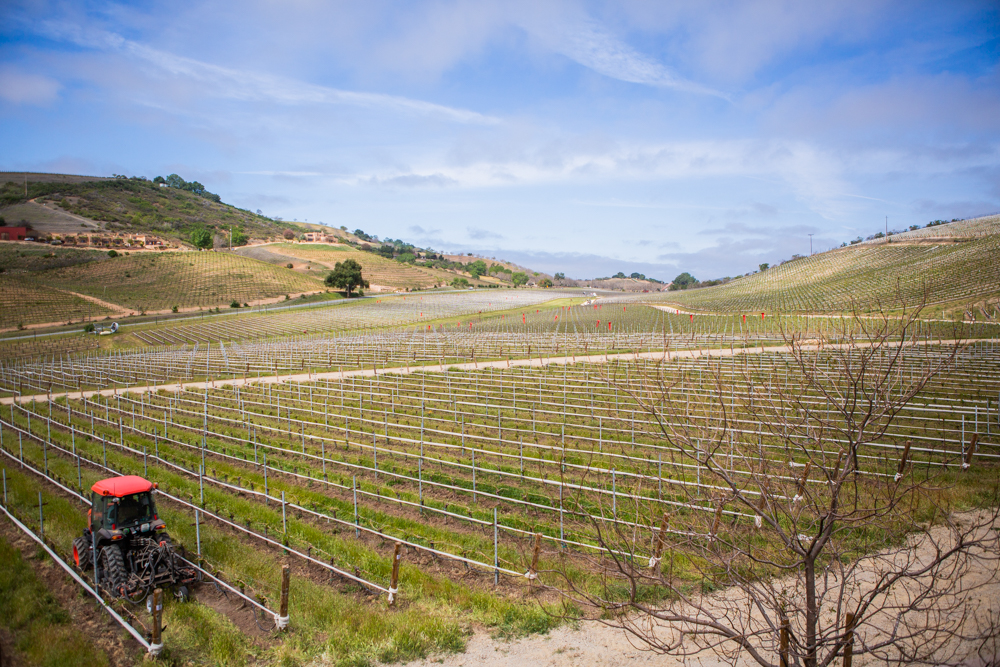
Parrish Adelaida Vineyard
My dad shared with me that we have been a part of a soil project the last couple of years that was implemented by the local RCD (a.k.a. Upper Salinas - Las Tablas Conservation District) and funded by the CDFA (a.k.a. California Department of Food and Agriculture). While my dad might have told me this before, it was like hearing new information and I had to know more. So, he directed me to our vineyard management company, Vineyard Professional Services (VPS), to fill me in. The Chief Operating Officer of VPS, Linnea Smith, reached out to me with a great document (thank you, Linnea!).
VPS has been working with the RCD to study the impact of middle row management and soil health over four years (2021 marks the last year). The reason for this study is that generally vineyard managers till between vineyard rows to reduce weeds and pests as they are competition for the vineyard's water...a precious resource. The problem with this practice is that it is expensive, time-consuming, and impacts erosion control. The updated practices are easy to implement and can be applied by any vineyard in California.
 Parrish Templeton Vineyard
Parrish Templeton Vineyard
In 2018, Parrish Family Vineyard's Templeton and Adelaida vineyards were brought into the trial along with three other local vineyards with diverse terroir; soil, and microclimates. In the trial, they tried different cover crops; brome grasses and barley. Then they tried a mix of mowing versus discing. The RCD took soil samples each year and observed the changes in the soil. They took note of the amount of organic matter, nutrient levels, and soil biology and diversity. The hope for the project is that it will lead to an increase of organic matter, improve water retention, and long-term storage of carbon in the soil.
In simple terms, the changed soil practices will mean less water, improved water quality, and fewer pests...overall making the vines productive. That's a win, win, win! This project shows how important soil is in the vineyard. Soil needs to have nutrients and water retention to feed the roots of the vines...otherwise, you will see problems with the season's development.
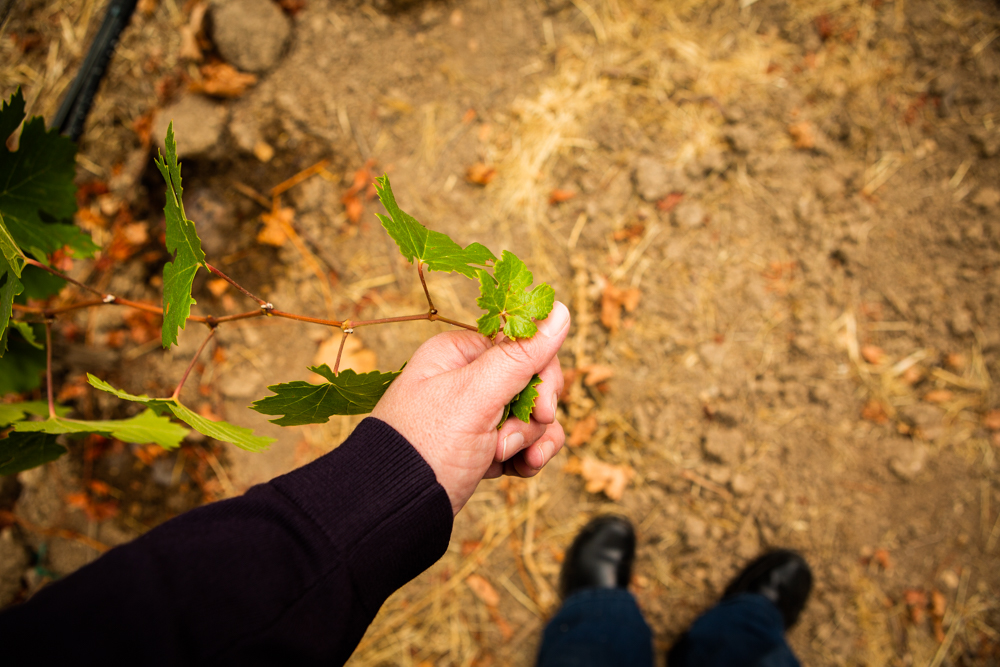
Thanks to the RCD and VPS for including Parrish Family Vineyard in these important trials. It is another example of the Ag Industry innovating and improving to meet the challenges around them. The farmer has always had to adapt and always will, due to climate, disease, pests, and economics.
We'll see how 2021 concludes for this project, so for now, we will wait with a glass of wine and appreciate the efforts as the wine starts in the vineyard.
Cheers!
Cecily Parrish Ray
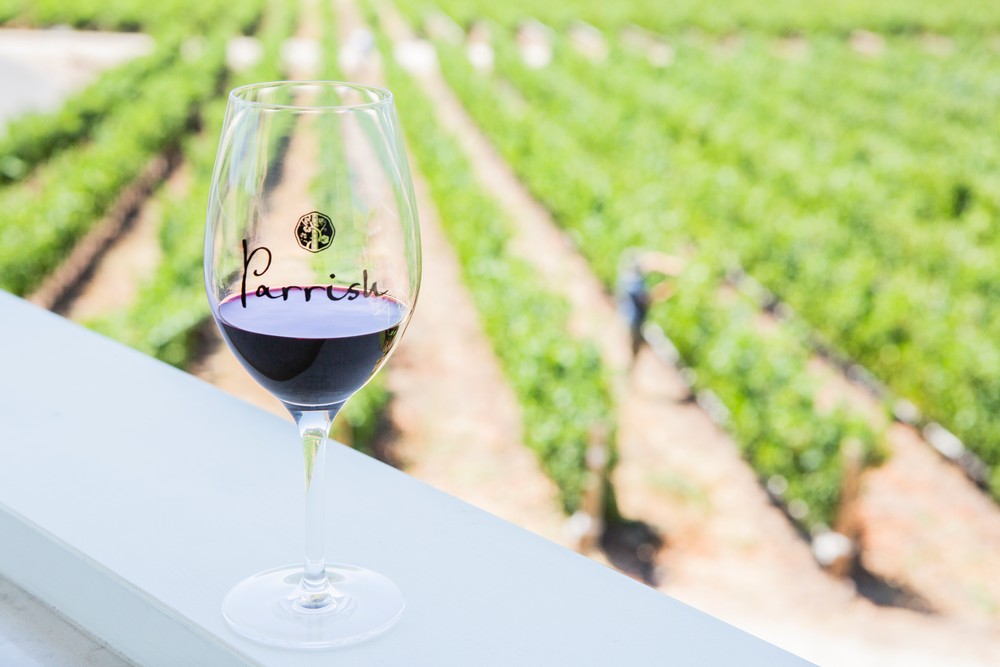
Late Harvest Sauvignon Blanc - Start to Finish
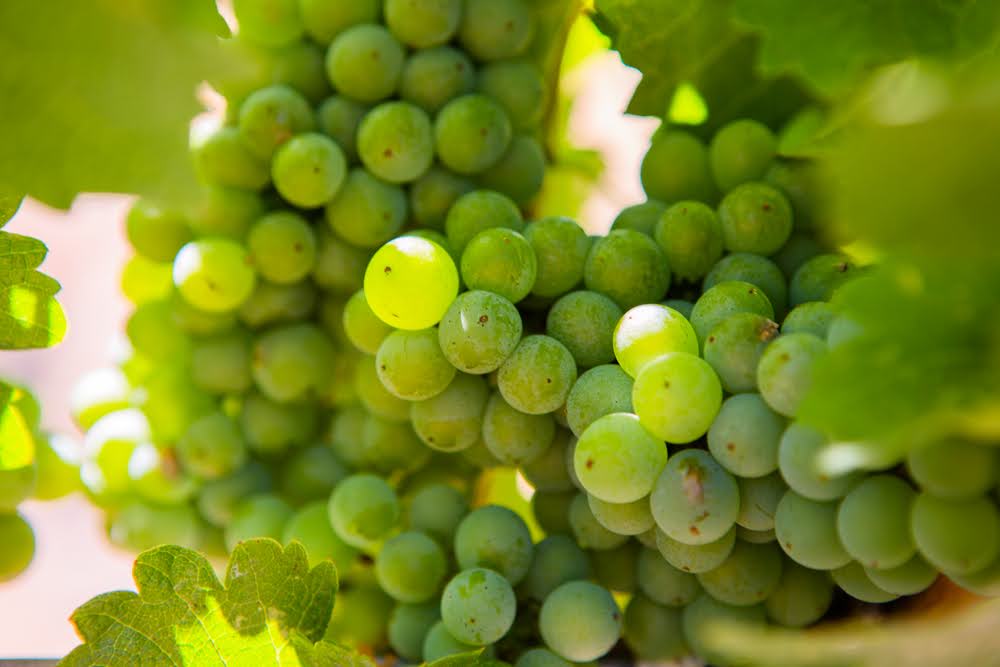
We have been growing our Sauvignon Blanc at the Adelaida vineyard since 2013, while we had been using the fruit to produce our Estate Sauvignon Blanc since 2016, the winemaking team was compelled to try something new. They wanted to do a sauterne-style wine as it would be a nice addition to our lineup as we didn't have a sweet wine.
What is a sauterne? Sauternes are from the Bordeaux region of France and they feature not only Sauvignon Blanc, but also Sémillon and Muscadelle. They tend to be heavier in body, sweet, and have notes of stone fruit, tropical fruit, florals, toasted sugar, coconut, and baking spices. It all depends on the fruit and barrel program, as you do age this style in barrels to add the wonderful body and secondary flavors.
Back in 2019 we took the leap and held back some Sauvignon Blanc clusters from the main harvest in September and allowed the grapes to stay on the vine to develop more sugar. In November 2019, we harvested the remaining Sauvignon Blanc and they were raisined with colors of gold and pink-purple. Hence the term, Late Harvest because it was last to be harvested and allowed to develop more sugar, or higher brix (measurement of sugar). We normally pick at 21 brix for the Sauvignon Blanc, but for this wine, we picked at about 35 brix.

Below is a video we recorded in the middle of the processing the Late Harvest Sauvignon Blanc with Cellar Master Ethan and Assistant Winemaker Cody sharing about this new wine:
*I'm sorry about the background buzz from the winery!
One thing you may notice from the video is the vibrant color. It looks like orange juice! That color fades away during fermentation. After talking with Assistant Winemaker Cody, I learned more about why young wines have a cloudy color that is nowhere near what the finished product will look like. This is known as browning and it's a normal thing that happens during pressing wine. The oxygen dissolves causing the color. It also has some lees and sediment that are stirred up making it not as clear. The CO2 that occurs in fermentation helps lift the oxygen and at that point begins to change the color to be more clarified and golden rather than yellow-orange.
During fermentation, the winemaking team used a weaker yeast so the process would stop at 15-16% alcohol and allow there to be residual sugar in the wine.
What is residual sugar? This is what makes wine sweet. Dry wines have no residual sugar because they have had all the sugar eaten up by yeast during fermentation. Sometimes wine tasters think that sweetness in a dry wine is sugar, but that is most likely the fruit notes of the palate. So, if you like wines that are "sweet" in a dry wine then you would want to look for wines that fruit-forward, less tannic, and have spent time in stainless steel or little time in the barrel.
After processing, the wine then journeyed to oak. The Late Harvest aged in 35% new French oak and 65% neutral oak for about 16 months. This gave the wine more body than our traditional Sauvignon Blanc. Typically, the winemaking team ages Sauvignon Blanc in stainless steel to keep it light and crisp, whereas the Late Harvest is aged to be heavier bodied with more creaminess and caramelization.

The day we bottled the Late Harvest Sauvignon Blanc, I got to taste it and it was delicious. The notes I got were apricot, lemon and grapefruit jelly candies (think of those Sunkist ones), cream soda, toffee, and then a beautiful brush of acidity. I love the acidity in this wine as it helps balance the body to keep it from becoming cloyingly sweet.

For the winemaking team, it is such a rewarding day to take the wines that have been worked on for a couple of months or years and finish them. They get to see the once grapes transformed to wine and then placed in the bottle. It is also rewarding for the team to do something new and have it turn out to be wonderful. No longer a thought, but a reality.
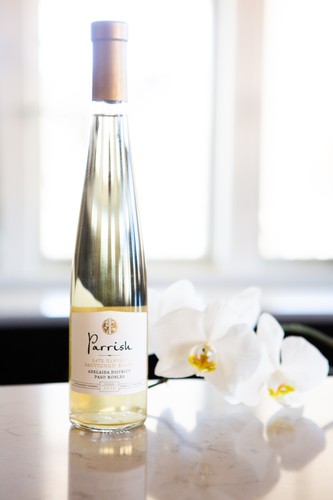
As far as packaging, it is different from our other bottles as the label is with gold accents and the bottle is smaller, 375ml (rather than 750ml). Our whole team voted on the bottle shape for a few days in bottle planning. It was very sophisticated as we lined up 2 options on the counter and then did a tally on post-it notes. It became a bit of a competition, jokingly, as one bottle was being picked by a landslide and the other was lonely with 1 tally mark. But that team member began convincing other team members to bring them to her side. Haha. Alas, the popular bottle was chosen. It was a good attempt! In summation, it was a team effort in picking the packaging.
So, importantly, how should you serve this? Chilled. I would recommend a smaller glass so you can easily access the nose. This will age well. I have yet to try it after being open a couple of days, but feel this would last longer open than a stainless steel, crisp Sauvignon Blanc. Regardless, this wine will age in the bottle for some time.
And then what do you pair it with? You can do dessert with this wine. I would say tarts would be lovely with it like a lemon, coconut, or almond. Cheesecake would be simple and decadent with the Late Harvest. For the release weekend, Estate Chef Samantha paired it with aphrodisiac macarons; fig & pistachio, strawberry balsamic, and raspberry chocolate (awesome!). The fig & pistachio macaron was my favorite with this wine, so taking inspiration to home, try thyme mascarpone figs with roasted pistachio and honey drizzle.

And then let's not forget cheese & charcuterie as this would be beautiful with a board for starters or dessert, I mean why not! Here are some thoughts; baked brie, Fromarer D'affinois Blue Cheese, St. Agur Blue Cheese, Cypress Grove Humboldt Fog, Asiago Rosemary, Idiazabal, Manchego, Honey Bee Goat Cheese, Oakdale Lemon Quark, Foie Gras, Duck Prosciutto, Alle Pia Calabrese Salami, and Smoking Goose Spruce & Candy Salame. Add some fun accouterments like quince paste, bacon jam (Olivas de Oro does one), Marcona almonds, dried nectarines, dried cherries, homemade candied pecans, pumpkin seeds, shortbread biscuits, sourdough, or brioche toast...you'll be set!
I hope you enjoyed learning more about this new wine. Cheers, and if you're a club member, you can pick up this wine here!
-Cecily
Winter in the Vineyard & A Quick Look at the Year
Winter is upon us with its calm and cold presence ushering in a quiet time for the vines. I have a lot of times called this their sleepy time, but in more formal words, the vines are currently dormant. It is a perfect time for dormancy as the temperatures can drop below 30 degrees. Even in Paso Robles, California we can get freezing temperatures at night and early mornings. So, dormancy protects the vineyard from being hurt by the freezing temperatures.
The vines have gone through senescence after the hard work of harvest, which is the dropping of leaves. Since the leaves are now covering the floor of the vineyard, it indicates that the vines have stopped photosynthesis (energy production). The vines don’t die because they have stopped photosynthesis, but rather they depend on the stored energy in their trunk and roots. This brings up one of the important practices for a vineyard and that is soil health. The soil is what provides nutrients to the vines. During this season we will work on the soil by applying fertilizer and/or planting cover crop seeds (i.e. flowers, vetch, or barley).
Shortly, we will also work on pruning the vines to prepare them for the growing season. With pruning, the prior year’s canes are cut back leaving the best canes for the new year’s shoots. There won’t be a lot of activity with the vines until bud break which usually occurs in April and marks the start of the growing season. Below I have dug up a timeline I made years ago of the stages of growth throughout the year highlighting the important moments for the vines. The months listed are approximate as every year is different due to the weather.
My hope this year is to share more information about the vineyard when they are happening, so we’ll see how I do!
Cheers!
Cecily Parrish Ray

Reflecting on 2020
It is December 31st, 2020. The last day of this year. Who would have foresaw during the joyous calls of "Happy New Year!" on January 1st, 2020 at 12am that this year would unfold the way it did. Normally we experience difficult times at different times, but in 2020 we experienced it at the same time. It has truly been a notable year for everyone that will be remembered.
It was a year that has brought about deep gratitude and togetherness despite what one would think. As I reflect on these photos and videos above, it amazes me to see such a year with vibrant life, colors, and joy. I believe the reason is that our family and team chose to make it that way. That is not to say that we haven’t had moments, but we chose to work hard together and keep going with the best attitudes possible. Thank you so much to them for all their hard work and team work. I truly could not have gotten through this year without them.
It was also a year of sharing with guests even though it was with distance and behind masks. There were so many moments and stories we got to experience with our members and guests that it brought us all closer. Thank you to all our club members and guests who trusted us to provide safe service. Thank you for the support and encouragement.
Lastly, it was a year of unexpected joy thanks to the location of our tasting room and winery. We saw the hills frame beautiful, inspiring sunsets. We had many visits from wild life from reptiles to birds…one we weren’t able to capture was a recent visit from a bobcat. It’s these moments that make us pause and remember that there is so much more to life than just the doom and gloom.
My heart is so full as I watch this video. Despite all the difficult and unimaginable, thank you God for such a year as this.
With a grateful heart,
Cecily Parrish Ray
Wine Pairings - Christmas Movies!

We were thinking that this is a perfect time for wine pairings with Christmas movies. Our family has always loved watching movies this time of year and there are a few that are tradition for Christmas Eve and Christmas Day. So here’s our list...
2018 Sauvignon Blanc – Rifftrax Christmas (Mystery Science Theater 3000 Fans)
2018 Chardonnay – The Santa Clause (1994)
2016 Petite Sirah – The Family Man (2000)
2016 Silken – While You Were Sleeping (1995)
2016 Four Chords – Christmas Carol (1951, traditionally on Christmas Eve)
2016 Estate Cabernet Sauvignon – Miracle on 34th Street (1947)
2016 Reserve Cabernet Sauvingon – It’s a Wonderful Life (1946, traditionally on Christmas Day)
Tomorrow is National Christmas Movie Marathon day, so grab a blanket, turn on the tree, and enjoy! We’re open 11am-5pm if you need some wine for this. Cheers!
Still Safely Open with Award of Excellence
Hello PFV Guests!
We received word (7/13/2020) that Govenor Newsom wants wine tasting experiences to continue outside only at this time. While we love our indoor space, we are blessed with spacious, beautiful outdoor areas giving us the ability to distance guests according to the guidelines. We have been following guidelines for our experiences upon reopening in late May with our team wearing masks and gloves to put your mind at ease during your visit. Our team, led by our Tasting Room Manager Lupita, also has been working hard to sanitinize surfaces through out the day. We have also been serving our delicious, fresh, comforting food by Estate Chef Samantha with plastic utensils and paper plates (the nicest we can find) as an extra precaution.
With all our effort, our team is happy to announce that late last week we were given an Award of Excellence by the San Luis Obispo County Environmental Health Services. We scored 100% on our routine inspection and passed in spades for the covid inspection. We are ready to continue serving you outside and are even looking into ways to cool our spaces during the Summer months (my dad is on it!). Thankfully we are looking at 80 degree weather this weekend!
If you are comfortable, we invite you to join us as we will continue to operate safely and we appreciate your patience as we work through this uncharted time together. Please feel free to visit our virtual tour, here, as it reflects the space we have (table distance has been modified since the video was shot).
Thank you to all who have supported us during this time. My family, my team are forever grateful to you.
Blessed,
Cecily Parrish Ray



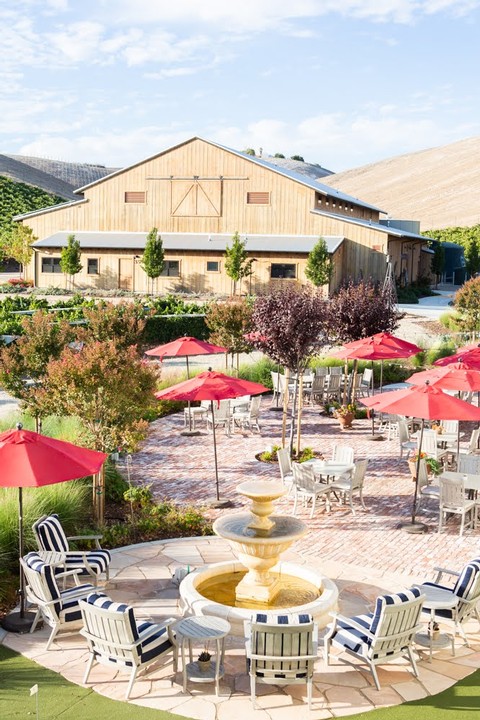
Easy Sourdough Starter + Tips
Sourghdough starters do sound challenging, but I hope to help make them more approachable as I was not born a bread baker. Starters are great for not only baking bread, but also cakes, cookies, and pasta. You can become your own bakery essentially, which is especially helpful being shut in. We have been making a Cabernet Sourdough since we opened in 2018. This starter was made from our Cabernet Sauvignon grapes, which you can read about on a previous blog post here. While I love our starter, it is not feasible for those at home wanting to start their own right now.
Two weeks ago I saw a starter recipe that looked really simple from Taste of Home and decided to try it a couple weeks ago. It went great, so without further ado I am going to share the recipe with a few tweaks, feeding info, and helpful starter info as I had a ton of questions when I started! Also, I will have a few tips if you are missing ingredients, or in need of a gluten free starter as everyone has different needs right now.
The Starter Recipe:
1 & ½ teaspoons (or a packet) of Yeast
2 Cups (11 oz) of Flour
2 Cups (16 oz) of Water at 70-75°F
Use a container like a large tupperware that you can put a lid on. Avoid a metal bowl for your starter as that will impact the temperature of your starter. You can use measuring spoons/cups or a digital scale. Digital scales tend to be more accurate. You will also need a thermometer to take the water temp.
*Yeast: Original recipe calls for Active Yeast. I used Instant Yeast and turned out just fine. Use what you have.
*Flour: The recipe calls for All Purpose (AP) Flour, but you could substitute for Bread Flour. Below I share the differences in flour.
Step 1 – Put 2 cups of flour the bowl/container.
Step 2 – Pour in yeast and stir with flour.
Step 3 – Measure 2 cups of water and take its temperature. 70-75°F is ideal for the temp, but if your home runs cooler or warmer, make adjustments. Like I'd do 80-85°F for a colder home. Yeast likes warmth and it encourages activity. I would avoid going over 90°F.
Step 4 – Gradually pour in the water, while stirring with a spatula. Stir until well incorporated. I like to stir for a few minutes to encourage the yeast to be active.
That’s it. You’ll notice it will become active and bubbly within hours. Let it hang out for about 4 days. Stirring occasionally throughout the day to encourage the yeast to be active. You will notice that it will start to smell more sour and a liquid will form on the top. All apart of it and it is fine. By day 4, feed the starter.
To Feed:
Step 1 – Stir the starter for a few minutes. Do not pour off the liquid. Some recipes do this, but I disagree as it’s just apart of the starter.
Step 2 – Pour out about ½ to 1 cup of starter. I did a cup.
Step 3 – Pour in 1 cup (8 oz) 70-75°F water and stir.
Step 4 – Pour in 1 cup (5.5 oz) of flour and stir. Stir as long as you can to encourage activity.
So, that’s the recipe, but here’s more info to help with your sourdough starter journey.
What is happening in the starter? Protein in the flour forms gluten. Yeast eats gluten and it produces CO2. The gluten helps the bread have strength and gives it rise. The water in the starter is helping the yeast move around and encourage the integration with the gluten. Also, yeast likes warmth and movement. So, the water temperature and the movement of the stirring encourage the activity.
There's no yeast in the stores right now? A real issue and there’s no need to panic. I have read blogs mentioning alternatives and one of those is…pineapple juice. This is similar to what we are doing with our grapes. Here's one I found on Breadtopia.
I’m gluten free? Okay! Well there’s sourdough starters that are gluten free…I found this on King Arthur's site.
Bread Flour vs. All Purpose Flour? Bread Flour has a higher gluten percent than All Purpose Flour (AP), which is why it is used for baking breads. The typical percentages are below:
- All Purpose is 10.5%
- Bread Flour 12.5%
- High Gluten Bread Flour 14%
The more gluten you have for the yeast to eat...the more activity you will have. That said if all you have is All Purpose or Wheat, making a starter will still work!
Storing the starter?
Method 1: Store on the counter and feed daily. This is great if you are a baker and bake daily.
Method 2: Store the starter in the fridge. So, the cold will cause the starter to slow down in activity. Upon removing from the fridge for use, feed more like 2-3 times a day for 2-3 days to awaken the starter.
Some starters can be kept in the fridge without feeding for up to a month or more. I would say this depends on the strength of your starter. If it's super active, then it will do great. I do usually up to a month for some of my starters.
Method 3: You can dry the starter on parchment during feeding. Take some of the starter and just spread it out on parchment paper and let it dry for a couple days. Then put the starter in a container like a mason jar. I recommend this for any starter you are discarding during feeding. Here's the article on King Arthur's site.
What is the liquid on top of the starter? So, believe it or not this is called hooch and that's because it is technically alcohol...the byproduct of the activity between yeast and gluten. It is okay and it doesn't mean that your starter is bad. Stir it into the starter and then feed your starter.
How can you tell if it has gone bad? Starters share a lot about themselves via smell. Sweeter means that it has been fed and is happy. Sour means that it is probably needing food.
Acetone and funky smells equals hmmm, something is awry. You just want to start feeding the starter, like you would when waking it up, to try to save it.
Mold or discolouration are a sign of no bueno. Just try your best to feed and save, but I would look at your saved dry starter at this point.
At feeding it feels wasteful, can I make something with the discarded (pitched) starter? Yes! Pancakes is a well-known option, but there are plenty of things you can do with pitched starter. You can dry some for storage. You can also give the pitched starter to someone else. Starter = giving.
How to know if your starter is ready for use? The visual activity of the bubbles will indicate its activity level, but again smell is important. In Tartine’s Bread, the sweeter smells it is fed and more ready to use. The more sour means it needs more feeding and time. I will say that with time you will get to know your starter and will have a feeling.
Another method is the Float Test. Take some of the starter (like a little piece) and put in water. If it floats, it’s ready for use. If it doesn’t float, well it’s not ready. This is not always accurate, keep in mind, according to some bakers.
Can you bake with whatever flour and the starter? You can bake with whatever flours you would like. Some recipes use blends for more flavor. You will get different textures and densities as well. Bread flour due to its higher gluten percentage will have better crumb (meaning the texture and hole pattern in the bread will be more desirable for the sourdough).
How sour does the sourdough get? The sourness of sourdough is just what the starter decides to create. It's the nature of your starter. So, do not be surprised if if it is not super sour. If you want more sourness to your sourdough bread, try using more starter in the recipe. Or try longer fermentation when making the dough.
Ideas for best bakes with sourdough bread? Dutch ovens are awesome and easy. You need steam for sourdough bread. Let's say you don’t have a dutch oven or cast iron with a lid and a water bath in your oven is a bit of a deal. This write up had some great ideas for getting steam going in your bake: https://truesourdough.com/3-ways-to-make-amazing-sourdough-bread-without-a-dutch-oven/
Best ways to store bread? Wrap in parchment, sarane wrap, and then leave on counter - lasts about 4 days-5days.
That was quite the write up, but I wanted to share thoughts and ideas that would encourage anyone to try their hand at this. This is a great project while stuck at home and/or you have some kids. Honestly, the starter becomes like a pet. You have to care for it. The Parrish team giggle at me as I will remember I have to feed my starter, or fold my bread in the midst of a meeting and rush out to care for it. Regardless of the amount of work it has brought to my life, I enjoy it and the fact that it brings joy to others.
Be well and Enjoy!
Cecily
